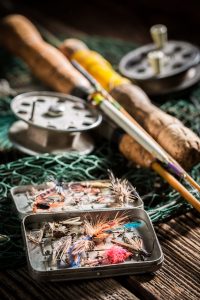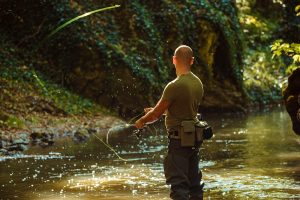Fly fishing, a revered sport and pastime, has captivated anglers worldwide with its unique blend of skill, patience, and connection with nature. This age-old technique, more art than mere fishing, invites enthusiasts to explore serene waters, whether they’re seasoned experts or just beginning their journey. It’s not just about the catch; it’s about the experience — the rhythmic dance of the rod and line, the careful selection of the perfect fly, and the thrill of outwitting the fish. In this guide, we delve into the essentials of fly fishing, offering insights and tips to enhance your experience in this rewarding pursuit.
Basics of Fly Fishing
 Equipment and Setup: The foundation of successful fly fishing and fly fishing techniques lies in selecting the right equipment. Key components include a fly rod, reel, and specialized line, each chosen based on the type of fish and environment. Beginners should start with a medium-sized rod (around 9 feet) and a matching reel and line. The fly, the lure that mimics aquatic insects, varies widely in size and color, designed to attract specific fish species. It’s crucial to balance these elements for a seamless fishing experience.
Equipment and Setup: The foundation of successful fly fishing and fly fishing techniques lies in selecting the right equipment. Key components include a fly rod, reel, and specialized line, each chosen based on the type of fish and environment. Beginners should start with a medium-sized rod (around 9 feet) and a matching reel and line. The fly, the lure that mimics aquatic insects, varies widely in size and color, designed to attract specific fish species. It’s crucial to balance these elements for a seamless fishing experience.
Choosing the Right Location: Location is paramount in fly fishing. Ideal spots are usually in moving waters like streams, rivers, or occasionally, still waters like lakes and ponds. Look for areas where fish naturally feed, such as where currents converge or in quieter pools just off the main stream flow. In these spots, fish are often found waiting for their next meal to float by. Beginners should seek locations with less dense foliage or obstacles to avoid snagging their line while casting.
Fly fishing is more than a method; it’s an immersive experience that brings you closer to the natural world. Understanding the basics of equipment and choosing the right location are the first steps in a journey that many find deeply rewarding and endlessly fascinating. As you grow in this sport, you’ll learn to read the water, understand fish behavior, and refine your technique, but it all starts with these foundational elements. Whether it’s the tranquility of a quiet stream or the excitement of a challenging catch, fly fishing offers a unique adventure for every angler.
Advanced Techniques
 Mastering the Cast: The essence of fly fishing lies in the art of casting, a skill that separates novices from seasoned anglers. Advanced casting techniques like the double haul increase line speed and distance, crucial for covering more water and reaching elusive fish. To master this, practice smooth, synchronized movements of the rod and line hand. The roll cast, another essential technique, is ideal for tight spots with limited backcasting room. It requires a deft flick of the wrist and precise timing to propel the line forward with minimal back movement.
Mastering the Cast: The essence of fly fishing lies in the art of casting, a skill that separates novices from seasoned anglers. Advanced casting techniques like the double haul increase line speed and distance, crucial for covering more water and reaching elusive fish. To master this, practice smooth, synchronized movements of the rod and line hand. The roll cast, another essential technique, is ideal for tight spots with limited backcasting room. It requires a deft flick of the wrist and precise timing to propel the line forward with minimal back movement.
Understanding Water Currents and Fish Behavior: Advanced fly fishing transcends mere technique; it’s about understanding the aquatic environment and fish psychology. Different water currents affect how fish feed and position themselves. In faster currents, fish often stay in slower pockets to conserve energy, making seams – where fast and slow waters meet – prime spots for casting your fly. Learning to read these currents and anticipate fish behavior is a game-changer.
Fly selection is another critical aspect. Beyond imitating the local insect life, consider factors like water clarity and light conditions. On overcast days, darker flies are more visible to fish, while brighter patterns work well in sunny conditions.
Stealth and observation are also key. Approach fishing spots quietly to avoid startling fish. Spend time observing the water, noting rises and fish movements, to tailor your approach accordingly.
Lastly, refine your technique to match the fish’s feeding habits. For surface feeders, dry fly fishing, where the fly sits atop the water, is effective. For fish feeding underwater, nymphing – using a weighted fly to sink below the surface – is often the go-to technique.
Advanced fly fishing is a constant learning process, blending skill, observation, and a deep understanding of the aquatic world. It’s this complexity that makes the sport endlessly fascinating and rewarding. With each cast and each day spent on the water, you’ll find new challenges and joys, deepening your connection with nature and honing your skills as an angler.
Gear Recommendations
Latest Fly Fishing Gear: Staying updated with the latest gear can significantly enhance your fly fishing experience. Rod technology has evolved, with newer models offering improved sensitivity and strength. Look for lightweight, yet durable rods that can withstand the challenges of different fishing environments. Reels have also seen advancements, with better drag systems ensuring smoother line retrieval and more efficient fish fighting capabilities.
When it comes to lines, consider the variety of options available, like weight-forward lines for longer casts or sinking lines for deep water fishing. The right choice depends on your fishing style and the typical conditions of your favorite spots.
DIY Tips for Fly Fishing Equipment: Personalizing your fly fishing gear not only saves money but also adds a unique touch to your fishing experience. One DIY project is creating your own flies. This not only allows for customization to local fish preferences but also adds an element of satisfaction to your catches. Basic fly-tying kits are available, and with some practice, you can create effective lures.
Another DIY aspect is the maintenance of your gear. Regular cleaning of your rod and reel, as well as proper storage, can significantly extend their lifespan. Learning to repair minor damages, like fixing a broken rod tip or replacing a worn line, can be both cost-effective and rewarding.
Lastly, consider modifying your tackle box or vest for better organization and accessibility. This can be as simple as adding extra compartments or waterproof sections to keep your gear safe and readily available.
Investing in the right gear and embracing DIY practices in fly fishing not only enhances your experience but also deepens your understanding and appreciation of the sport. Whether it’s through using the latest technology or adding a personal touch to your equipment, these aspects play a crucial role in the journey of every fly fisher.
Fly Fishing Destinations
Fly fishing is a global adventure, offering diverse and exhilarating experiences across various landscapes. From tranquil mountain streams to expansive coastal waters, the world is full of incredible destinations for fly fishers.
Top Global Spots for Fly Fishing: When it comes to renowned fly fishing locations, several destinations stand out. Montana, USA, is a fly fisher’s paradise, with its legendary rivers like the Big Sky and Yellowstone offering abundant trout populations. New Zealand’s South Island, known for its crystal-clear waters, presents a more challenging but rewarding experience with large, elusive trout.
In Europe, Slovenia’s Soča Valley offers stunning scenery and unique marble trout fishing opportunities. For those seeking a tropical experience, the flats of the Bahamas are world-famous for bonefish, providing an entirely different fly fishing challenge.
Hidden Gems for Seasoned Anglers: Beyond these well-known spots, numerous hidden gems await discovery. In Japan, the mountain streams of Hokkaido are a haven for fly fishing, especially for native species like the Iwana. Iceland, with its rugged landscapes and abundant salmon rivers, offers both isolation and exceptional fishing experiences.
In Patagonia, Argentina, remote and unspoiled rivers await, offering the chance to fish in solitude amidst breathtaking scenery. Closer to the equator, the Amazon Basin is not only home to a vast array of wildlife but also provides unique fly fishing opportunities for species like the peacock bass.
Each of these destinations offers something special, whether it’s the fish, the environment, or the overall experience. Choosing the right location can depend on your skill level, the type of fishing you enjoy, and the kind of adventure you seek. From chasing specific species to exploring new waters, the world of fly fishing is as vast as it is thrilling, with each destination offering a unique chapter in your fly fishing story.
As we’ve journeyed through the intricacies and joys of fly fishing, it’s clear that this sport offers more than just a catch; it’s a gateway to connecting with nature, honing a skill, and finding tranquility. Whether you’re just beginning or have years of experience, each cast brings a new lesson and a deeper appreciation for the art of fly fishing. We encourage you to take these tips and techniques to the water, explore new destinations, and share your stories. Join the community of fly fishers, share your experiences, and continue to learn and grow in this endlessly rewarding pursuit.

